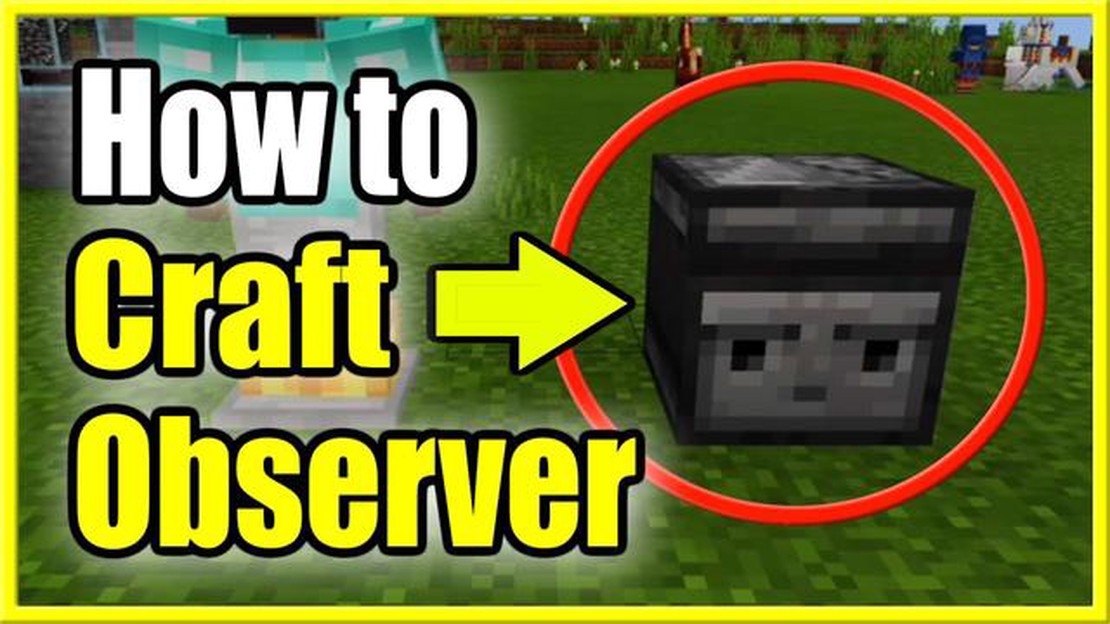Discover the Age of Scaramouche in Genshin Impact - All You Need to Know
How Old Is Scaramouche Genshin Impact? Genshin Impact, the popular action role-playing game developed by miHoYo, has captured the hearts of millions …
Read Article
In Minecraft, observers are nifty redstone devices that can detect changes in block states and emit a redstone signal. They can be a crucial component in various automated systems and contraptions, allowing players to create intricate mechanisms.
To make an observer in Minecraft, you will need several resources. The key ingredient is cobblestone, which can be easily obtained by mining stone blocks. You will also need two redstone dust and six smooth stone slabs.
Here is a step-by-step guide on how to make observers in Minecraft:
Now you have successfully crafted observers in Minecraft! Observers can be placed and oriented in various ways to detect changes in block states and activate redstone mechanisms. Experiment with different set-ups to create intricate and automated systems in your Minecraft world!
Note: Observers can also be obtained by finding them in generated structures or through trading with villagers.
So, go ahead and start using observers in your Minecraft world to create amazing contraptions and automated systems!
In Minecraft, observers are a block that act as a Redstone component. They emit a Redstone signal when they detect a specific event or change in the blocks around them. Observers are commonly used in redstone contraptions and circuits, as they can detect changes and trigger other redstone devices.
The main purpose of an observer is to detect block updates. The block in front of the observer is the one that triggers the detection. If a block updates its state, such as a block being placed or destroyed, or certain blocks changing their state, like a crop growing or a door opening, the observer will detect the change and emit a Redstone signal.
Observers can detect a wide range of events, including changes in the state of blocks, the growth of crops or plants, the opening or closing of doors, the activation or deactivation of Redstone components, and even changes in the weather or time of day.
Observers can be used in various ways to create complex redstone contraptions. They can be used to create automatic doors, detect player movement, trigger hidden traps, activate pistons, and much more. The possibilities are only limited by your imagination and knowledge of redstone mechanics.
To craft an observer in Minecraft, you will need 6 cobblestones, 2 redstone dust, and 1 nether quartz. Place the cobblestones along the bottom and middle rows of the crafting table, with the nether quartz in the center slot of the middle row, and the redstone dust in the top row.
Here is a step-by-step guide on how to make observers in Minecraft:
Read Also: Easy Ways to Contact Coin Master: Get Help and Support
That’s it! You’ve successfully crafted an observer in Minecraft.
To make observers in Minecraft, you will need the following materials:
Read Also: Learn How To Send A KOF Skin in Mobile Legends: Bang Bang
Note: If you don’t have the necessary materials, make sure to gather them by exploring caves, mining, or trading with villagers.
To make an observer block in Minecraft, you will need the following ingredients:
To craft the observer block, follow these steps:
Now that you have successfully crafted an observer block, you can use it in your Minecraft world to create different contraptions and automate certain tasks.
Once you have crafted the observer block, it’s time to place it in your Minecraft world. Follow these steps:
It’s important to note that the observer block has a front and a back. The face with the red dot represents the front and the face without the red dot represents the back. Make sure to position the observer block correctly so that it is facing the direction you want it to observe.
Now that you have successfully placed the observer block, you can move on to the next step and learn how to use it to detect changes in your Minecraft world.
An observer in Minecraft is a block that is used to detect changes in its surroundings and emit a redstone signal.
To craft an observer in Minecraft, you will need 6 cobblestones, 2 redstone dust, and 1 nether quartz. Arrange the items in a specific pattern on a crafting table to create the observer block.
An observer can be used for various purposes in Minecraft. It can detect block updates, player movements, and even the growth of crops. It is often used in redstone contraptions and automated systems.
Yes, observers can be used to create automatic farms in Minecraft. By placing observers near crops, you can detect when they grow and trigger a mechanism to automatically harvest them.
How Old Is Scaramouche Genshin Impact? Genshin Impact, the popular action role-playing game developed by miHoYo, has captured the hearts of millions …
Read ArticleHow to complete Blackguard Big Boggart’s quest in Elden Ring Welcome to our comprehensive guide on how to complete the challenging Blackguard Big …
Read ArticleWho Is Dream Minecraft? If you’ve ever heard of the world of Minecraft, chances are you’ve also heard of Dream. This enigmatic figure burst onto the …
Read ArticleHow To Make Slime In Toca Boca Life World? Have you always wanted to learn how to make your own slime? Look no further! Table Of Contents What is Toca …
Read ArticleHow To Use Fanny Mobile Legends? If you’re new to Mobile Legends and looking to improve your skills with Fanny, you’ve come to the right place. Fanny …
Read ArticleHow To Get Mechanical Parts Fortnite? Fortnite is a popular online game that features a range of weapons and equipment for players to use in their …
Read Article